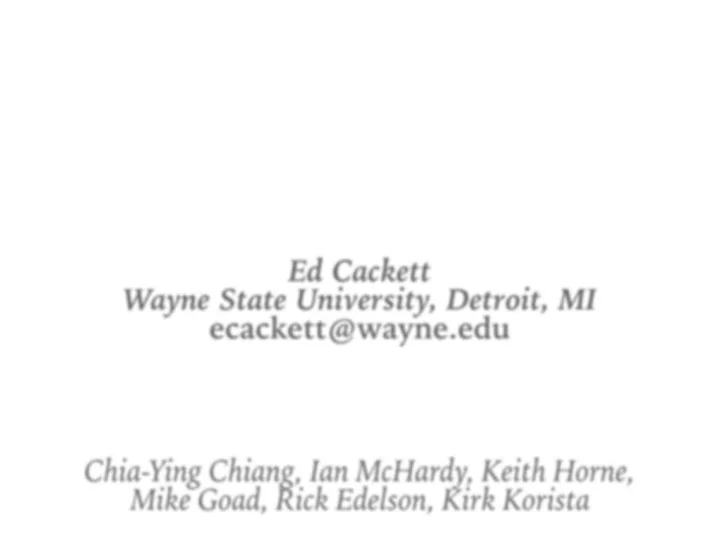

NGC 4593 MONITORING PROGRAM: HST RESULTS Ed Cackett Wayne State University, Detroit, MI ecackett@wayne.edu Chia-Ying Chiang, Ian McHardy, Keith Horne, Mike Goad, Rick Edelson, Kirk Korista
THERMAL REPROCESSING ➤ Hot, inner disk sees variable irradiating source before cooler, outer disk ➤ Expect correlated continuum bands, with lags that depend on the temperature profile of the disk X-ray UV Optical Hot Cold
TEMPERATURE PROFILE � 1 / 4 � 3 GM ˙ 8 πσ R 3 + (1 − A ) L X H M T ( R ) = 4 πσ R 3 Viscous Irradiation T = X hc where X ~ 3 for blackbody radiation assuming a flux-weighted emission radius k λ M ) 1 / 3 λ 4 / 3 M ) 1 / 3 T − 4 / 3 τ ∝ ( M ˙ R ∝ ( M ˙ for a classical geometrically thin, optically thick disk see, e.g. Collier et al. (1999), Cackett et al. (2007), Fausnaugh et al. (2016)
KEY AGN STORM NGC 5548 RESULT: DISK APPEARS TO BE A FACTOR OF 3 TOO BIG ➤ Moreover, X-rays are not well-correlated and not the driving lightcurve (Starkey et al. 2016, Gardner & Done 2016) ➤ Enhanced u-band lag may indicate contribution from Balmer continuum (Edelson et al. 2015, Fausnaugh et al. 2016) Fausnaugh et al. (2016) (see also McHardy et al. 2014; Edelson et al. 2015)
WHY IS THE DISK TOO BIG? ➤ Contribution of broad lines to photometric bands will enhance lags (e.g. Chelouche et al. 2013), but, not a large effect in NGC 5548 (Fausnaugh et al. 2016) ➤ BLR diffuse continuum lags (Korista & Goad 2001 - see more from Mike later) ➤ Gardner & Done (2017) suggest there is a puffed-up Comptonized disk between X-ray emitting region and UV/optical region ➤ Inhomogeneous disk (Dexter & Agol 2010) ➤ Tilted inner disk (Starkey et al. 2016)
NGC 4151 WITH SWIFT 0.010 0.008 Hard X 0.45 A BAT 0.006 0.004 0.002 0.000 0.8 ➤ Campaign from early 2016 0.6 1.8 A X4 0.4 0.2 (Edelson et al. 2017) 0.0 1.2 1.0 0.8 3.5 A X3 0.6 ➤ 6 hour sampling (!!) for 0.4 0.2 0.0 4 X-ray 0.20 69 days (319 0.15 7.8 A X2 0.10 bands observations) 0.05 0.00 0.25 0.20 ➤ > 3-day lag from X-ray to 23 A X1 0.15 0.10 0.05 UV , but, < 1-day lag from 0.00 7.0 6.5 1928 A UV uvw2 UV to optical 6.0 5.5 6.0 2246 A uvm2 5.5 5.0 1 6.0 2600 A uvw1 5.5 5.0 0 4.8 4.6 Lag (days) 4.4 3465 A 4.2 − 1 u 4.0 3.8 3.6 3.4 3.8 − 2 4392 A 3.6 b 3.4 3.2 − 3 3.0 3.5 3.4 3.3 5468 A V 3.2 v 3.1 − 4 3.0 2.9 57440 57450 57460 57470 57480 57490 57500 0 1000 2000 3000 4000 5000 Modified Julian Date Wavelength (A)
NGC 4593 WITH SWIFT, HUBBLE AND KEPLER ➤ NGC 4593 was in the Kepler field of view from July - October 2016 (PI: Edelson) ➤ Visibility overlapped with Swift & HST for July 2016 only (unfortunately safe- mode ultimately limited Kepler overlap even further) ➤ Swift gives high cadence, high S/N lightcurves (~200 obs over 23 days; PI: McHardy, see his talk) ➤ Monitoring with HST once per day for 27 days (PI: Cackett) Major advantages to this approach: ➤ Low-resolution HST spectroscopy allows to cleanly pick out continuum bands over a wide wavelength range ➤ In one orbit we get G140L, G430L and G750L covering 1100 Å to 10000 Å (with just a small gap in the near-UV) ➤ It also covers and resolves the Balmer jump (3646 Å ) — a key diagnostic of the diffuse BLR contribution
LIGHTCURVES ➤ We’ve gotten used to seeing all the beautiful lightcurves at once, along with the CCF and centroid distributions ➤ So, here we go………
LIGHTCURVES - A FEW SELECT BANDS
WAVELENGTH-DEPENDENT LAGS ➤ Lags via standard FR/RSS w.r.t. Swift /W2 ➤ Clear discontinuity around the Balmer jump ➤ Does not follow λ 4/3 everywhere Red: Swift Black: HST Blue: Swift/W2
MEAN, RMS AND LAG SPECTRA ➤ Calculate lags using ICCF and a sliding box to get a ‘lag spectrum’
G140L Ly α C IV MEAN, RMS & LAG SPECTRA SiIV ➤ Lots of work still to do on emission line reverberation with these data G430L H ɣ H α G750L H β H δ [OIII]
DYNAMIC CCF G140L ➤ Plot the CCF at each wavelength to create a dynamic CCF G430L G750L
SIGNIFICANT DIFFUSE CONTINUUM CONTRIBUTION TO LAGS ➤ Lags now shown w.r.t. X-ray ➤ DC lags dominate shortward of 4000 Å ➤ No X-ray offset when including the DC model ➤ Disk lags still a factor of 3 larger than expected ➤ Blue dotted: λ 4/3 ➤ Red dashed: diffuse continuum lags from BLR (model from Mike & Kirk) ➤ Purple: overall model
Recommend
More recommend